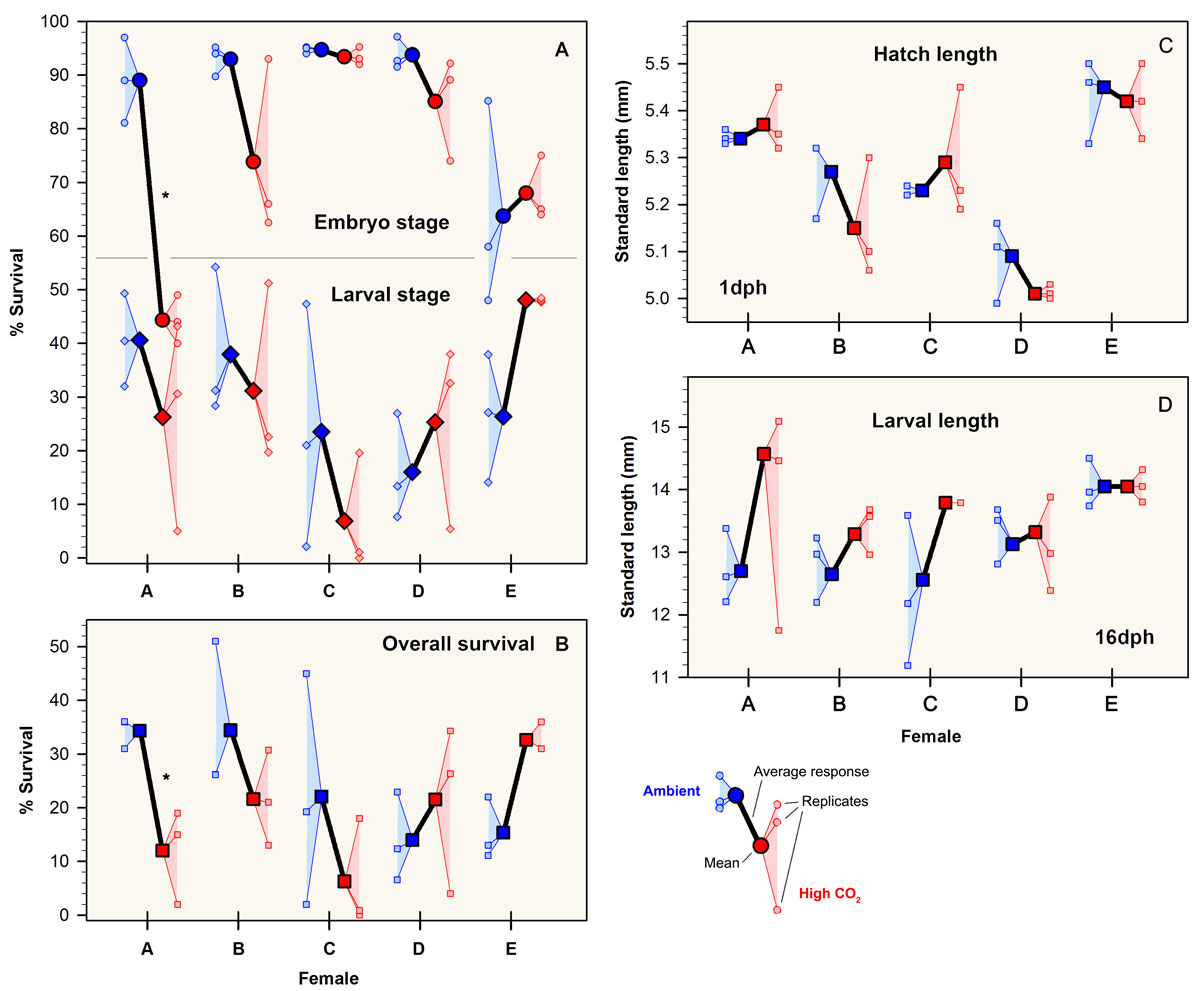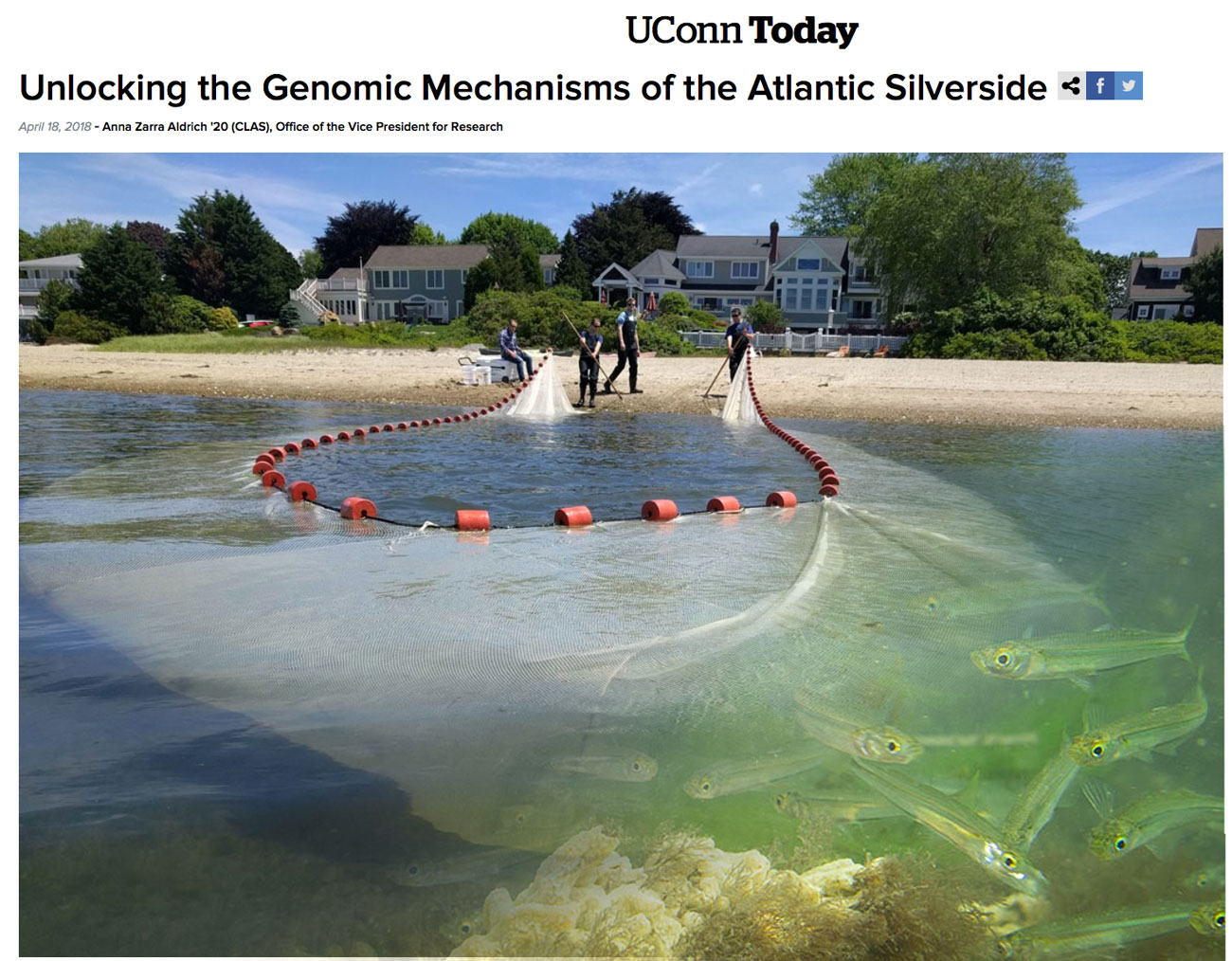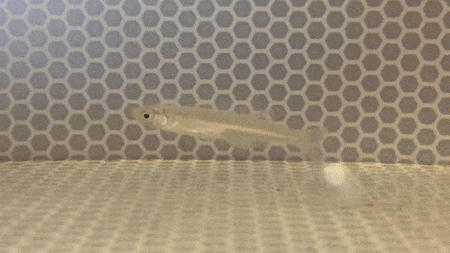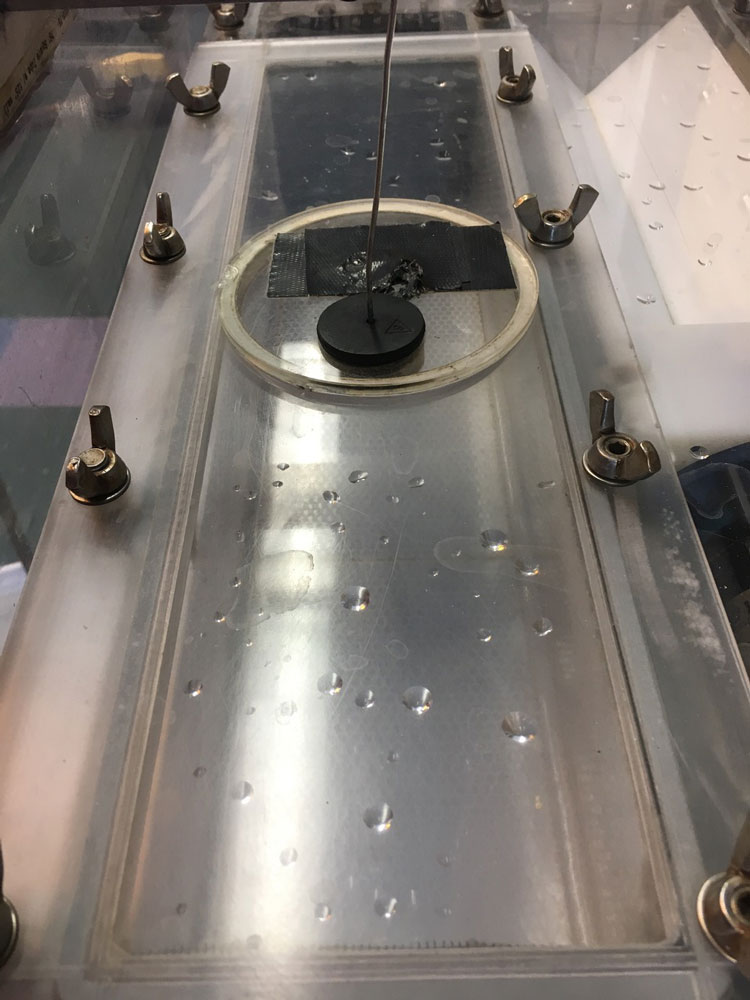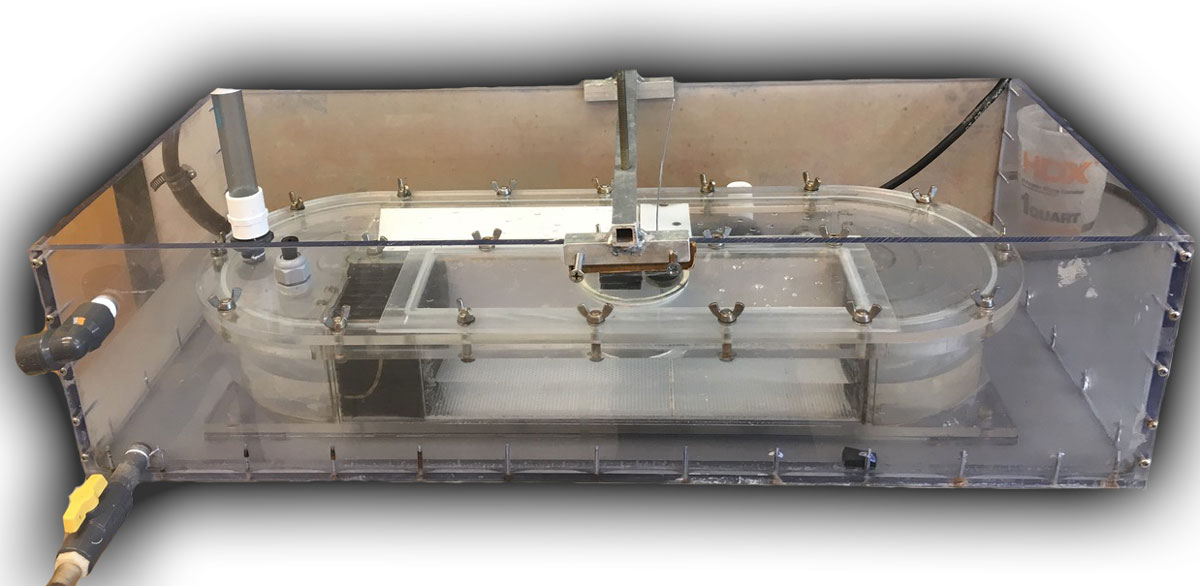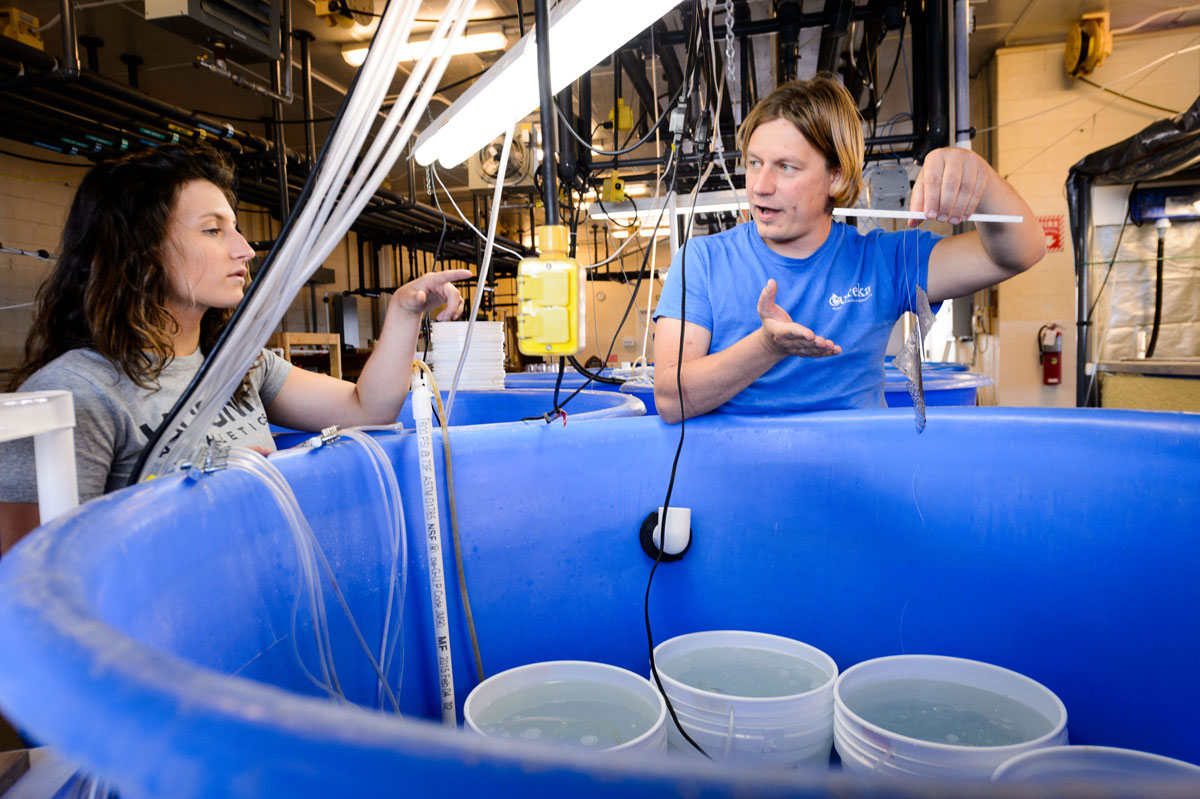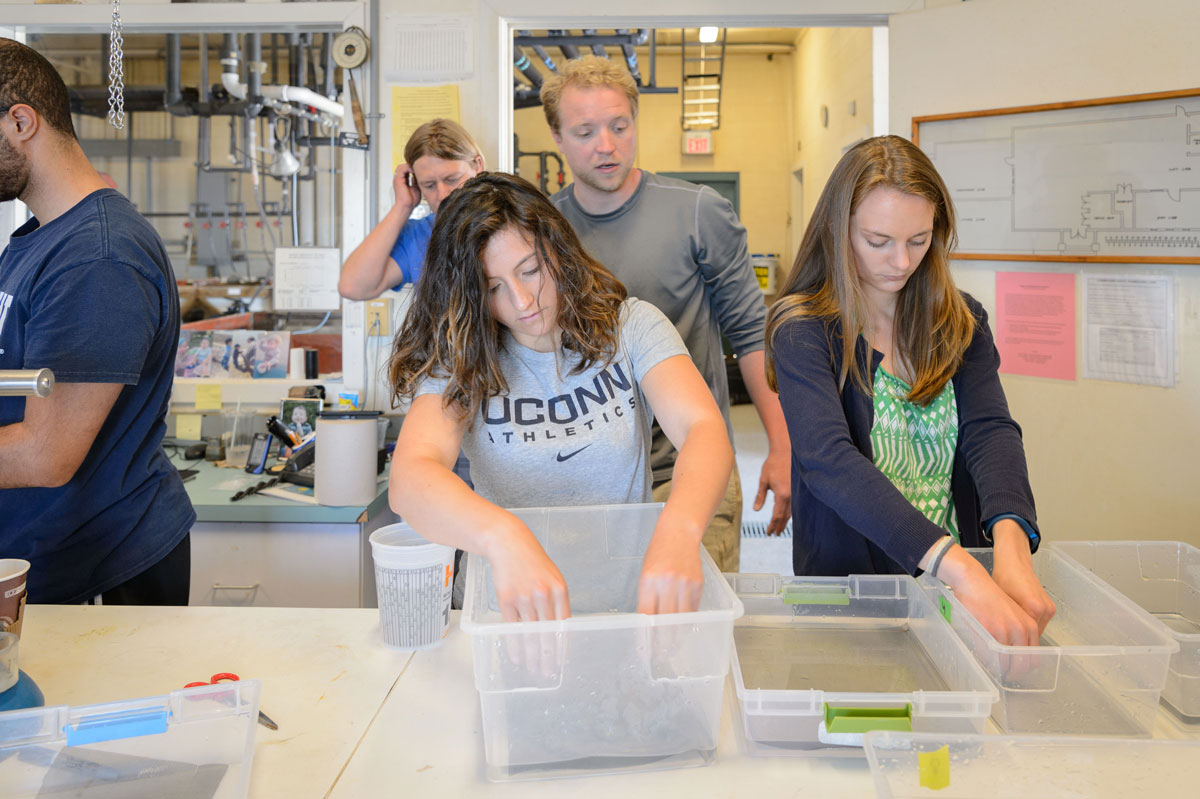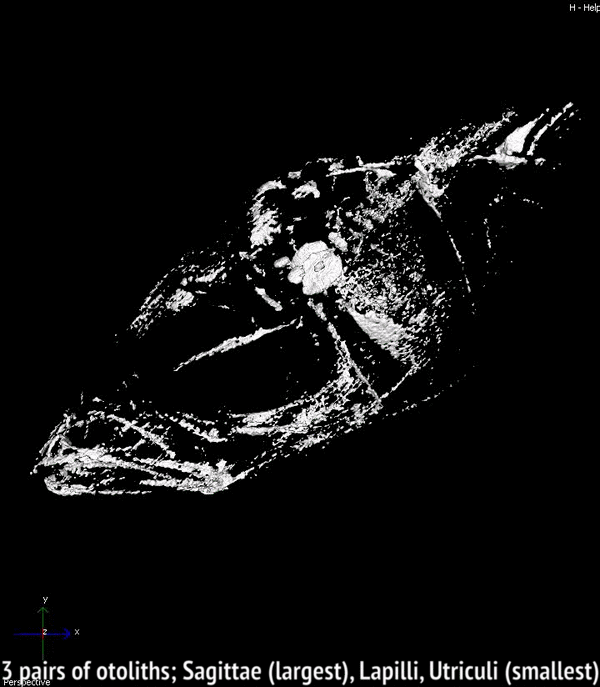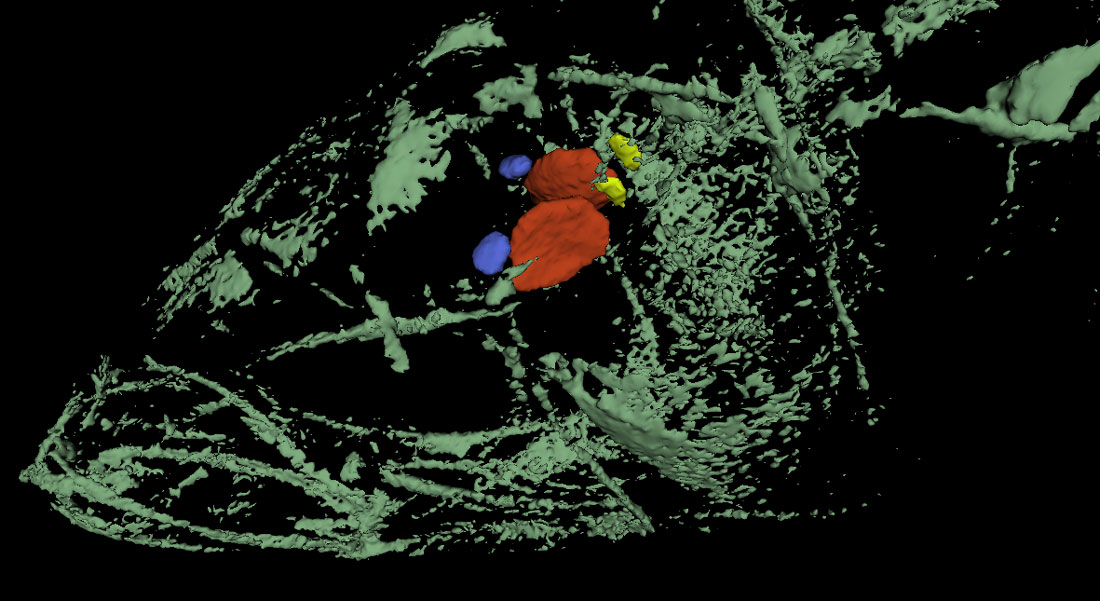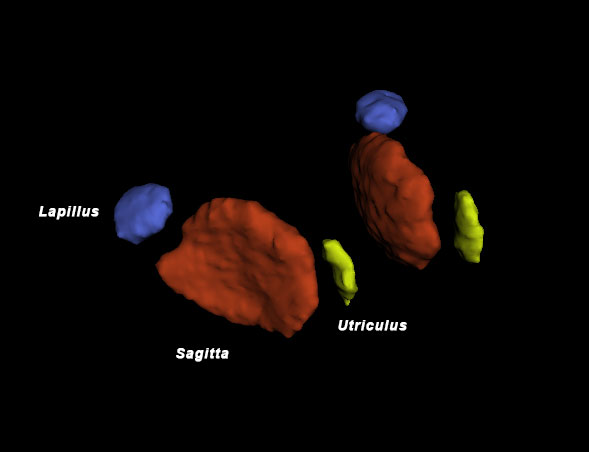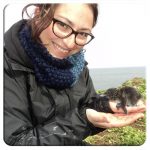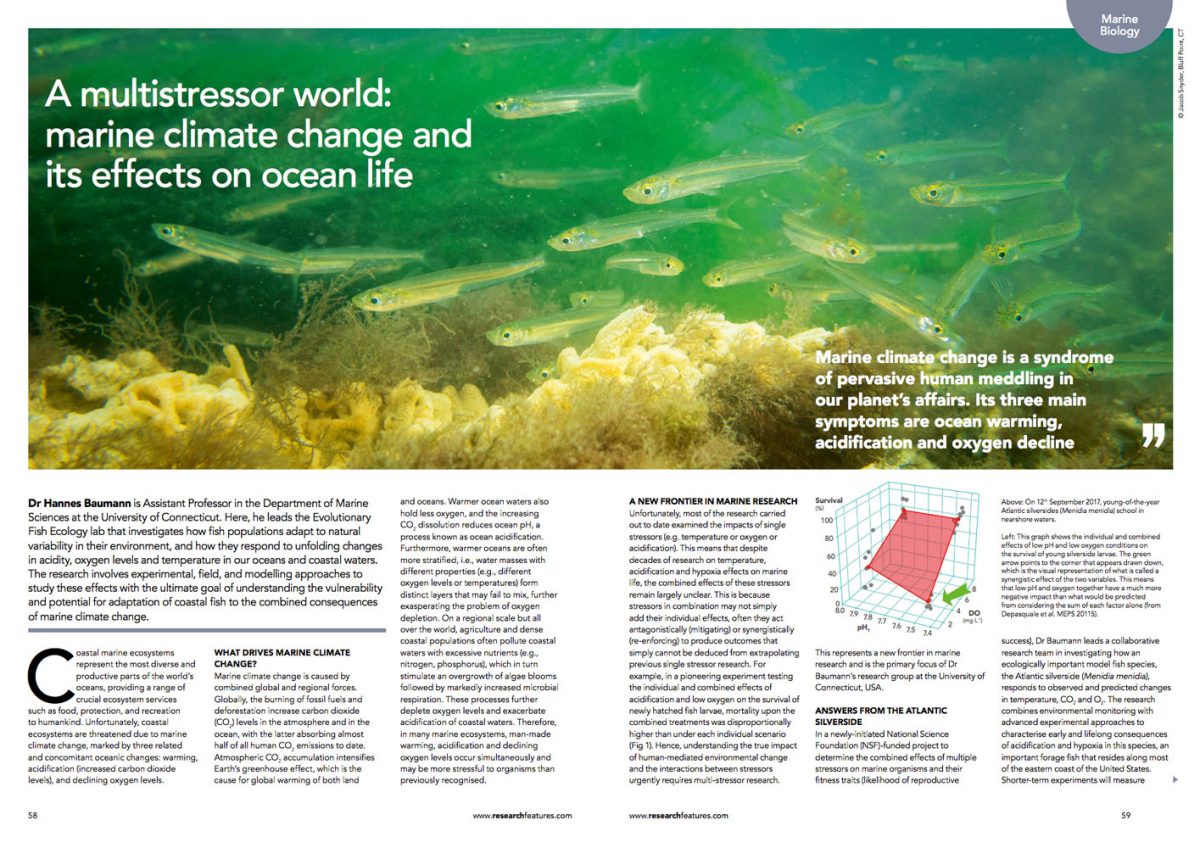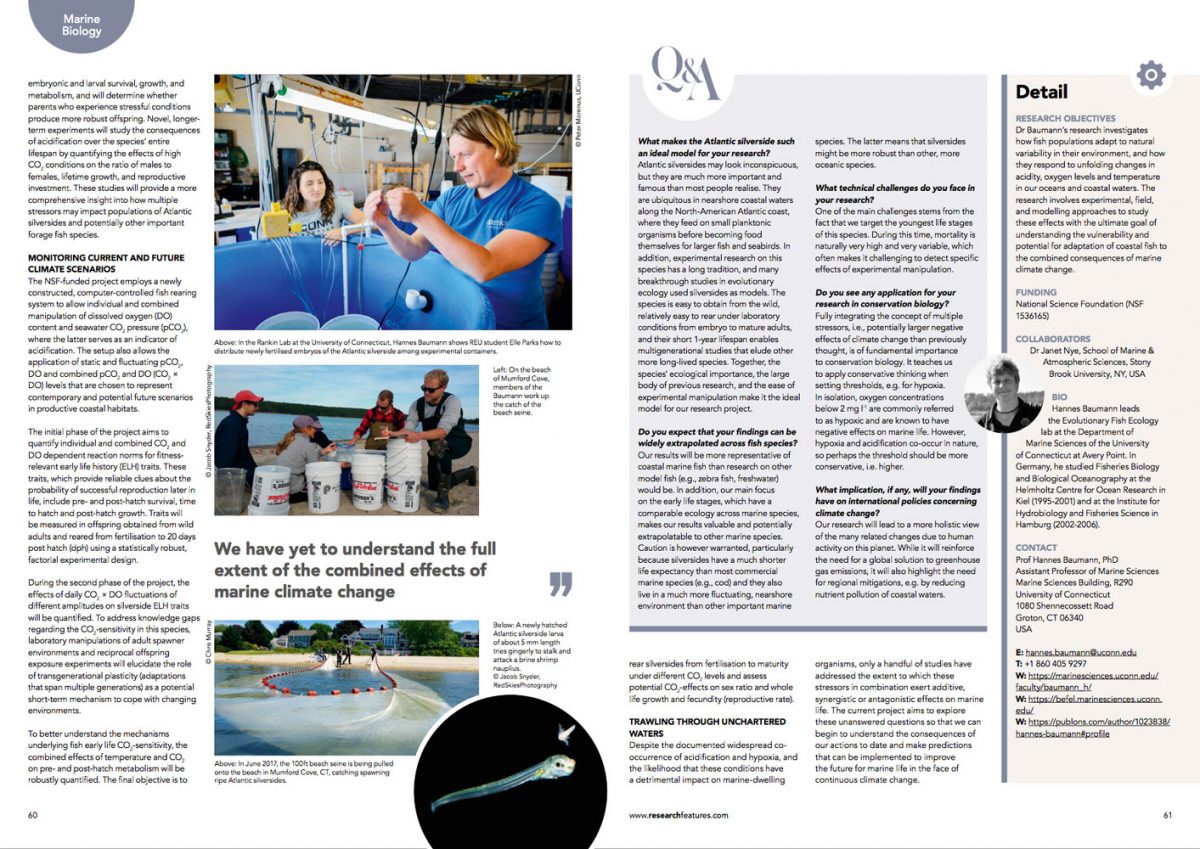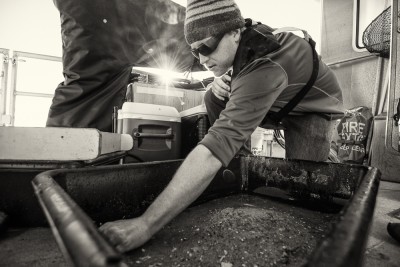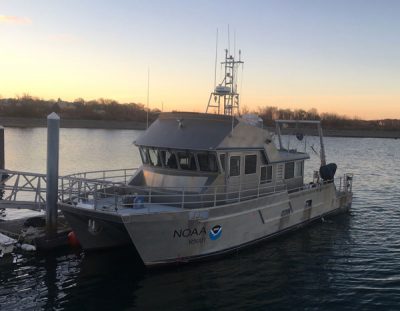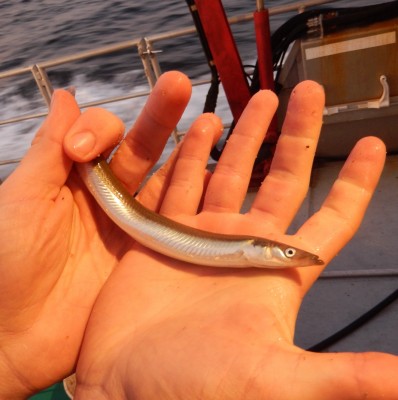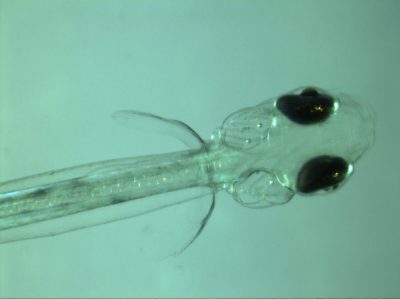On 18 May 2018, the Baumann lab teemed with activity. Maria Akopyan from Cornell University was busy phenotyping juvenile silversides for our Menidia Gene project. Mia and Mackenzie were busy working up field samples of silversides. And Hannes prepared adult silverside samples for later analyses.
Research News
[Funding] UConn Today announces new NSF-silverside project
Click on the link or the image blow to access the article in UConn Today …
[Lab news] The old swim flume coming back to life
4 April 2018. Today, Adelle Molina and Teresa Schwemmer from the Nye Lab at Stony Brook University visited us with a bunch of respirometry equipment in tow. We were trying to find out how to measure critical swimming speeds and oxygen consumption on individual silverside juveniles. This information, along with other individual traits such as growth, lipid content, and vertebral number will later be used in our new NSF-project examining the genetic underpinnings of local adaptation in this species.
One crucial piece of equipment to do this work is a swimming chamber, also called swim flume. The one we will use is almost 20 years old and has already been used for silverside work more than a decade ago. After a long odyssey through several labs and institutions in the US, we finally got hold of it again, gave it some serious TLC and now hope to resurrect it. Thanks to our pro’s from Stony Brook, the first tests were promising today! Thank you Adelle and Teresa.
[New publication] No CO2 effects on silverside starvation
- Baumann, H., Parks, E.M.*, and Murray, C.S.* (2018)
Starvation rates in larval and juvenile Atlantic silversides (Menidia menidia) are unaffected by high CO2 conditions.
Marine Biology 165:75-83
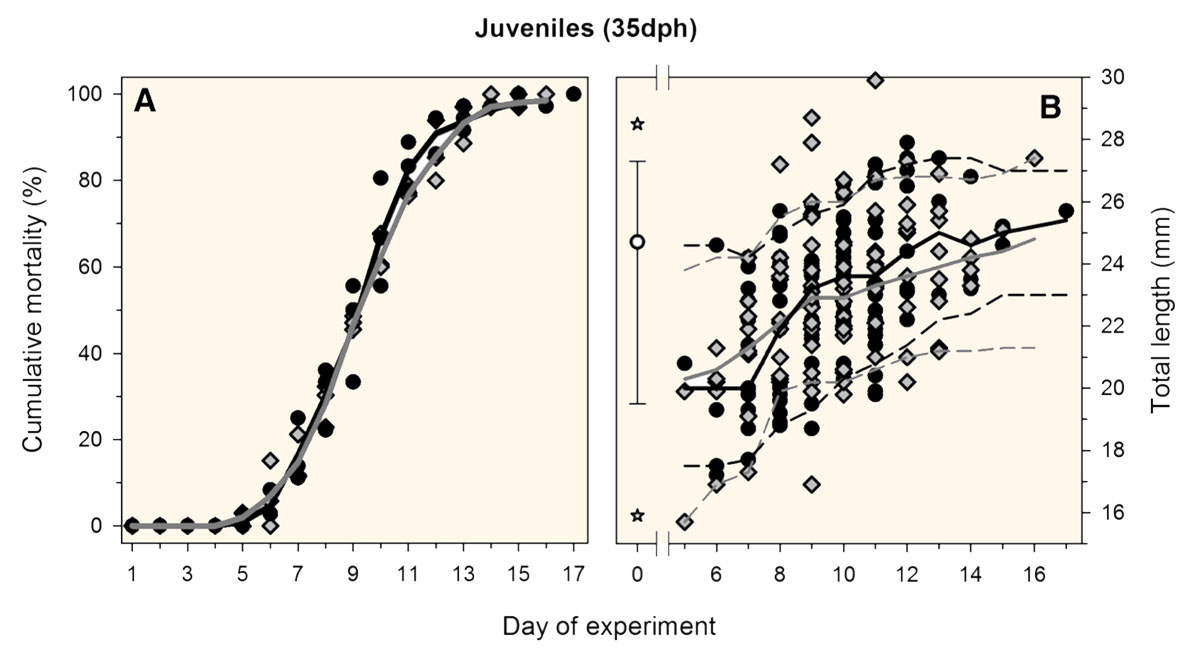
[Research news] Silversides in a CT scanner
26 March 2018. Today we got our first glimpse of an incredible new way of imaging the inner calcified structures of a fish body, particularly the ear bones (otoliths), of which every teleost fish has six, three on each side inside the skull. Otoliths are long known to fish ecologists for their properties to record and store information about a fish’s age, growth and habitat. With an adult Atlantic silverside, Hannes visited John Shepherd, facilities scientist and member of the Goldhamer lab at UConn, Storrs (Biology Physics Building), who showed us the use of a new, state-of-the-art micro CT-scanner (IVIS). Turns out, the system effortlessly imaged all six otoliths inside of the fish’s head. Later in the year, we will use the technique to image silversides reared at contrasting CO2 conditions to see whether they differ in their otolith size, volume, and structure. Thank you, John, for this truly inspiring demonstration!
[New publication] Brachiopods resilient to global change
Congratulations to Emma Cross to her new publication in Global Change Biology today!
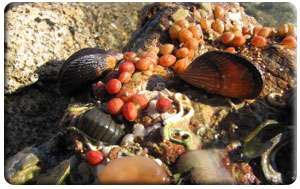
Read the full press release by the British Antarctic Survey
- Cross et al. 2018. A 120-year record of resilience to environmental change in brachiopods.
Global Change Biology published online 14 March 2018
[Research news] New NSF grant to study silverside genes!
We are overjoyed to announce that NSF is funding a new and collaborative research project to look at the genomic underpinning of local adaptation in the Atlantic silverside! Check out below for a first glimpse of the project website.

Oceans are large, open habitats, where it was previously believed that the lack of obvious barriers to dispersal would result in extensive mixing, thereby preventing organisms from adapting genetically to particular habitats. It has recently become clear, however, that many marine species are subdivided into multiple populations that have evolved to thrive best under contrasting local environmental conditions. Nevertheless, we still know very little about the genomic mechanisms that enable divergent adaptations in the face of ongoing intermixing.
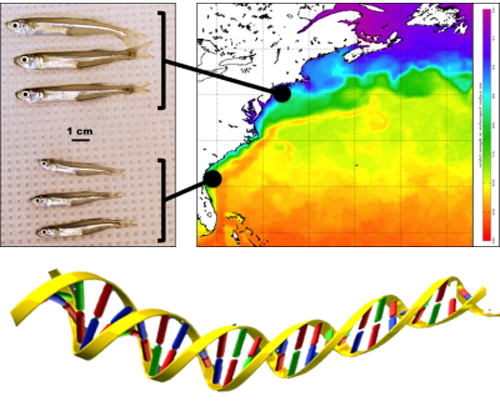
The project is organized into four interconnected components
[Research feature] Our multistressor NSF project in the spotlight
This research feature makes the case for multistressor research to a broad general audience and introduces our NSF project and its participants. Download the feature by clicking on the pictures or the link below.
[Research news] Are sand lance embryos particularly sensitive to high CO2?
On this dimly lit November afternoon, rain mercilessly drenched scientists and crew on board the R/V Auk as it slowly navigated the waters of Stellwagen Bank. A world like a wet sponge. Sky and ocean, indistinguishable.
Thanksgiving, the next day.
Despite the circumstances, the team’s mood was nothing short of elated. Our small beam trawl had just spilled hundreds of silvery fish on deck, wriggling like eels. They were Northern sand lance (Ammodytes dubius).
Running ripe adults.
Spawning.
Apparently, they like Thanksgiving, too.
—————
As the ship docked back in the Scituate, Mass., harbor that day, the rain thinned to hazy darkness.
“Let’s get a coffee and then on the road,” mumbled Chris, who led the team, “the real work of the experiments has just begun.”
Sand lance have a few interesting and rare characteristics. They alternate between schooling and foraging in the upper water column and extended periods of being almost completely buried in sand. For that, they rely on sand of a particular grain size and with very little organic content. It’s the kind of sand that defines large areas of the Stellwagen Bank.
Surprisingly little is known about the ecology and ecosystem importance of this sand lance species, although research on its European relatives (A. tobianus, A. marinus) is more advanced. In particular, experiments on early life stages of Northern sand lance have been lacking, save for some pioneering work on rearing methods of the related A. americanus (Smigielski et al. 1984). One question that was of particular interest to our lab involved the potential sensitivity of this fish species to carbon dioxide (CO2). That’s due to two other interesting and rare characteristics of sand lance. They spawn in late fall and winter in cold (and still cooling) waters, which is why their eggs and larvae develop extremely slow compared to other, more typical spring and summer spawning species. In addition, the species is found not in nearshore, but offshore coastal waters, where smaller seasonal and daily CO2 fluctuations more closely resemble oceanic conditions. Could sand lance offspring be particularly sensitive to higher levels of oceanic carbon dioxide predicted during the next 100 to 300 years as climate change effects intensify?
Our experiments are still ongoing, and rearing protocols are being improved.
The preliminary findings, however, are stunning. Survival to hatch was dramatically reduced under elevated and high compared to baseline CO2 conditions. It was severely lowered at higher (10°C or 50°F) compared to lower temperatures (5°C or 41°F). Our second experiment this year appears to repeat this pattern. If these results continue, that would mean sand lance is one of the most CO2-sensitive species studied to date.
General interest in sand lance goes beyond its sensitivity to carbon dioxide. Given the species importance for the ecosystem and coastal economy, there are now increasing efforts to better understand sand lance feeding ecology, distribution and relationship to the rest of the food web. In this regard, funding of our project by the Northeast Sea Grant Consortium proved prescient and a seed for subsequent grants from MIT Sea Grant and the Bureau of Energy Management (BOEM) to continue the work. Surely, the groundswell of interest in sand lance is commensurate with its importance and will enable insights into better management strategies for sensitive ecosystems like those along the U.S. Atlantic coast.
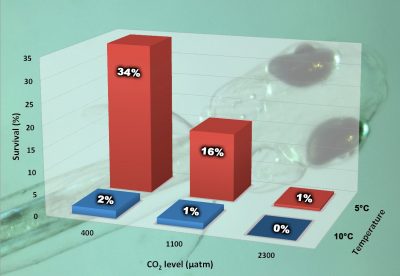
Collaborators on this project are: D. Wiley of the National Oceanic and Atmospheric Administration-Stellwagen Bank National Marine Sanctuary; P. Valentine of the U.S. Geological Survey; and S. Gallagher and J. Llopiz, both of the Woods Hole Oceanographic Institution.
[New publication] Mothers matter for the CO2 sensitivity of fish offspring
28 November 2017. The Journal of Experimental Marine Biology and Ecology just published the latest study by our group looking at differences in the CO2 sensitivity of Atlantic silverside offspring stemming from different mothers. Congratulations to Jacob Snyder for his first peer-reviewed publication.
Among the highlights of the study:
- Offspring produced by different females varied in their sensitivity to high CO2 conditions.
- Specific fatty acids in eggs were correlated to the log-transformed CO2 response ratio of embryo survival and hatch length.
- Maternal provisioning might be an additional determinant of CO2 sensitivity in fish early life stages.
Citation:
Snyder, J.T.*, Murray, C.S.*, and Baumann, H. (2018)
Potential for maternal effects on offspring CO2 sensitivities in the Atlantic silverside (Menidia menidia).
Journal of Experimental Marine Biology and Ecology 499:1-8
